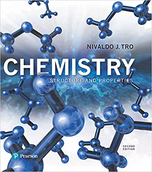?Note: Answers to all odd-numbered Problems, numbered in blue, can
Chapter 2, Problem 94(choose chapter or problem)
Note: Answers to all odd-numbered Problems, numbered in blue, can be found in Appendix III. Exercises in the Problems by Topic section are paired, with each odd-numbered problem followed by a similar even-numbered problem. Exercises in the Cumulative Problems section are also paired but more loosely. Because of their nature, Challenge Problems and Conceptual Problems are unpaired.
The energy of a vibrating molecule is quantized much like the energy of an electron in the hydrogen atom. The energy levels of a vibrating molecule re given by the equation
\(E_{n}=\left(n+\frac{1}{2}\right) h v\)
where n n is a quantum number with possible values of 1, 2,., and v is the frequency of vibration. The vibration frequency of HCl is approximately \(8.85 \times 10^{13} \mathrm{~s}^{-1}\). What minimum energy is required to excite a vibration in HCl? What wavelength of light is required to excite this vibration?
Text Transcription:
E_n = (n+1/2)hv
8.85 times 10^13 s^-1
Unfortunately, we don't have that question answered yet. But you can get it answered in just 5 hours by Logging in or Becoming a subscriber.
Becoming a subscriber
Or look for another answer
